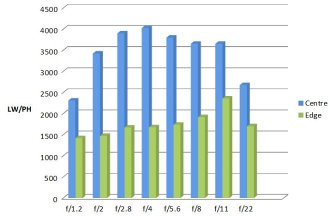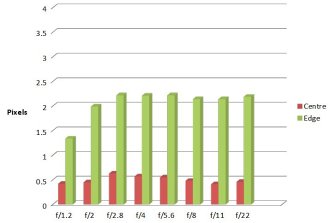DZOptics Kerlee 35mm f/1.2 Lens Review
DZOptics Kerlee 35mm f/1.2 Performance
In general, the lens produces very crisp and pleasing images, with an extremely smooth bokeh effect enhanced by the wide apertures available and the virtually circular aperture. Distortion measure at -2.1% barrelling, noticeable but correctable in software. It errs on the right side of things as we tend to accept some barrel distortion in wide angle lenses.
In terms of sharpness, when we look at the central performance this lens is head and shoulders above the norm for ultra-fast manual focus primes. Even at f/1.2 sharpness is good and by f/2 is snaps into place and is excellent. From f/2.8 to f/5.6 central performance is outstanding, remaining excellent as we move from f/8 to f/11. Results are still very good at f/22.
The edges do not match the centre, being quite soft from f/1.2 through to f/5.6, just a fair performance. Sharpness however becomes good at f/8, very good at f/11 and is still very good at f/22.
If fine detail at the edges is required, then stopping down to f/8 to f/11 would be the best option, with a peak at f/11. The edges are relatively soft at the other apertures, yielding fair results. Best results are to be had between f/2 and f/11 if the main subject is central, and here the end result will be superb as the central sharpness is very impressive indeed.
How to read our charts
The blue column represents readings from the centre of the picture frame at the various apertures and the green is from the edges.The scale on the left side is an indication of actual image resolution as LW/PH and is described in detail above. The taller the column, the better the lens performance.
For this review, the lens was tested on a Sony Alpha A7R II using Imatest.
CA (chromatic aberration) is quite noticeable at the edges, being over 2 pixels wide. Again we can look to software to reduce this when required. At the centre though, correction is approaching perfect, being less than one third of a pixel wide at most apertures.
How to read our charts
Chromatic aberration is the lens' inability to focus on the sensor or film all colours of visible light at the same point. Severe chromatic aberration gives a noticeable fringing or a halo effect around sharp edges within the picture. It can be cured in software.Apochromatic lenses have special lens elements (aspheric, extra-low dispersion etc) to minimize the problem, hence they usually cost more.
For this review, the lens was tested on a Sony Alpha A7R II using Imatest.
The Achilles heel of the lens, its weakest point, is probably in terms of flare. It is quite susceptible, despite the fine lens hood. In quite a few images, even though the sun is well shielded, flare makes its way into the image area. So some caution is needed when shooting against the light.
Value For Money
At the time of writing, no final price is set, but if we anticipate something around £450-485 ($629 US) then a comparison could be made between the Kerlee lens and the alternatives for the mounts it will be available in. For a start, there is no other 35mm f/1.2 lens for full frame, any other lenses having been for rangefinder cameras. So the nearest comparison is between this and the 35mm f/1.4 lenses.
The Sigma 35mm f/1.4 is priced at £599, the Canon EF 35mm f/1.4 L USM at £959, the Canon EF 35mm f/1.4 L II USM £1799, the Nikon 35mm f/1.4 G AF-S £1399 and the Sony 35mm f/1.4 G £1099. All these are AF lenses.
There is also the Samyang 35mm f/1.4 AS UMC manual focus lens at £349.
On this basis the Kerlee 35mm f/1.2 would be very good value, being also quite unique with its f/1.2 aperture. However, this is not a price written in stone, so we shall have to wait and see.
Add your message
Please login here or if you've not registered, you can register here. Registering is safe, quick and free.
photodo Stats
428 MTF tests
74 in-depth photodo reviews
100+ users join each day
Help the lens community by reviewing or rating a lens today via our lens search
Latest Lens Reviews
- Chinon 28mm f/2.8 Vintage Lens Review
- Canon EF 70-200mm f/4L IS II USM Lens Review
- Samyang AF 85mm f/1.4 EF Review
- Sigma 70mm f/2.8 DG Macro Art Review
- Samyang AF 24mm f/2.8 FE Review
- Meike 50mm f/1.7 Review
- Tamron 70-210mm f/4 Di VC USD Review
- Lensbaby Burnside 35mm f/2.8 Review
- Asahi Super Takumar 50mm f/1.4 Review
- Asahi Super-Multi-Coated Takumar 135mm f/3.5 Review


